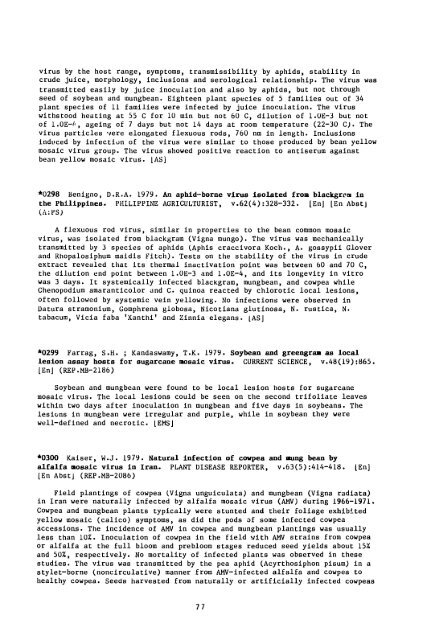PNABD246.pdf
PNABD246.pdf
PNABD246.pdf
You also want an ePaper? Increase the reach of your titles
YUMPU automatically turns print PDFs into web optimized ePapers that Google loves.
virus by the host range, symptoms, transmissibility by aphids, stability in<br />
crude juice, morphology, inclusions and serological relationship. The virus was<br />
transmitted easily by juice inoculation and also by aphids, but not through<br />
seed of soybean and mungbean. Eighteen plant species of 5 families out of 34<br />
plant species of 11 families were infected by juice inoculation. The virus<br />
withstood heating at 55 C for 10 min but not 60 C, dilution of 1.UE-3 but not<br />
of 1.0E-", ageing of 7 days but not 14 days at room temperature (22-30 C). The<br />
virus particles were elongated flexuous rods, 760 nm in length. Inclusions<br />
induced by infection of the virus were similar to those produced by bean yellow<br />
mosaic virus group. The virus showed positive reaction to antiserum against<br />
bean yellow mosaic virus. [AS]<br />
*0298 Benigno, D.R.A. 1979. An aphid-borne virus isolated from blackgrom in<br />
the Philippines. PHILIPPINE AGRICULTURIST, v.62(4):328-332. [En] [En Abst]<br />
(A:PS)<br />
A flexuous rod virus, similar in properties to the bean common mosaic<br />
virus, was isolated from blackgram (Vigna mungo). The virus was mechanically<br />
transmitted by 3 species of aphids (Aphis craccivora Koch., A. gossypii Glover<br />
and Rhopalosiphum maidis Fitch). Tests on the stability of the virus in crude<br />
extract revealed that its thermal inactivation point was between b0 and 70 C,<br />
the dilution end point between I.OE-3 and 1.OE-4, and its longevity in vitro<br />
was 3 days. It systemically infected blackgram, mungbean, and cowpea while<br />
Chenopodium amaranticolor and C. quinoa reacted by chlorotic local lesions,<br />
often followed by systemic vein yellowing. No infections were observed in<br />
Datura stramonium, Gomphrena globosa, Nicotiana glutinosa, N. rustica, N.<br />
tabacum, Vicia faba 'Xanthi' and Zinnia elegans. [AS]<br />
*0299 Farrag, S.H. ; Kandaswamy, T.K. 1979. Soybean and greengram as local<br />
lesion assay hosts for sugarcane mosaic virus. CURRENT SCIENCE, v.48(19):865.<br />
[En] (REP.MB-2186)<br />
Soybean and mungbean were found to be local lesion hosts for sugarcane<br />
mosaic virus. The local lesions could be seen on the second trifoliate leaves<br />
within two days after inoculation in mungbean and five days in soybeans. The<br />
lesions in mungbean were irregular and purple, while in soybean they were<br />
well-defined and necrotic. [EMS]<br />
*0300 Kaiser, W.J. 1979. Natural infection of cowpea and mung bean by<br />
alfalfa mosaic virus in Iran. PLANT DISEASE REPORTER, v.63(5):414-418. [En]<br />
[En Abst] (REP.MB-2086)<br />
Field plantings of cowpea (Vigna unguiculata) and mungbean (Vigna radiata)<br />
in Iran were naturally infected by alfalfa mosaic virus (AMV) during 1966-1971.<br />
Cowpea and mungbean plants typically were stunted and their foliage exhibited<br />
yellow mosaic (calico) symptoms, as did the pods of some infected cowpea<br />
accessions. The incidence of AMV in cowpea and mungbean plantings was usually<br />
less than 10%. Inoculation of cowpea in the field with AMV strains from cowpea<br />
or alfalfa at the full bloom and prebloom stages reduced seed yields about 15%<br />
and 50%, respectively. No mortality of infected plants was observed in these<br />
studies. The virus was transmitted by the pea aphid (Acyrthosiphon pisum) in a<br />
stylet-borne (noncirculative) manner from AMV-infected alfalfa and cowpea to<br />
healthy cowpea. Seeds harvested from naturally or artificially infected cowpeas<br />
77

















